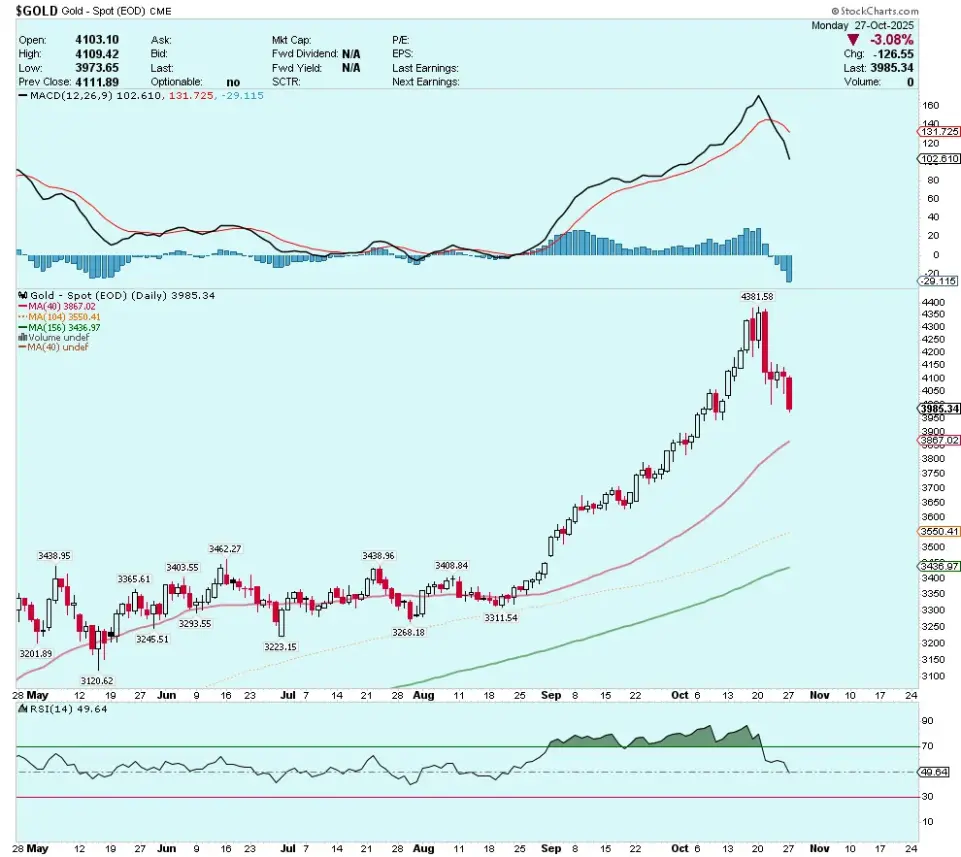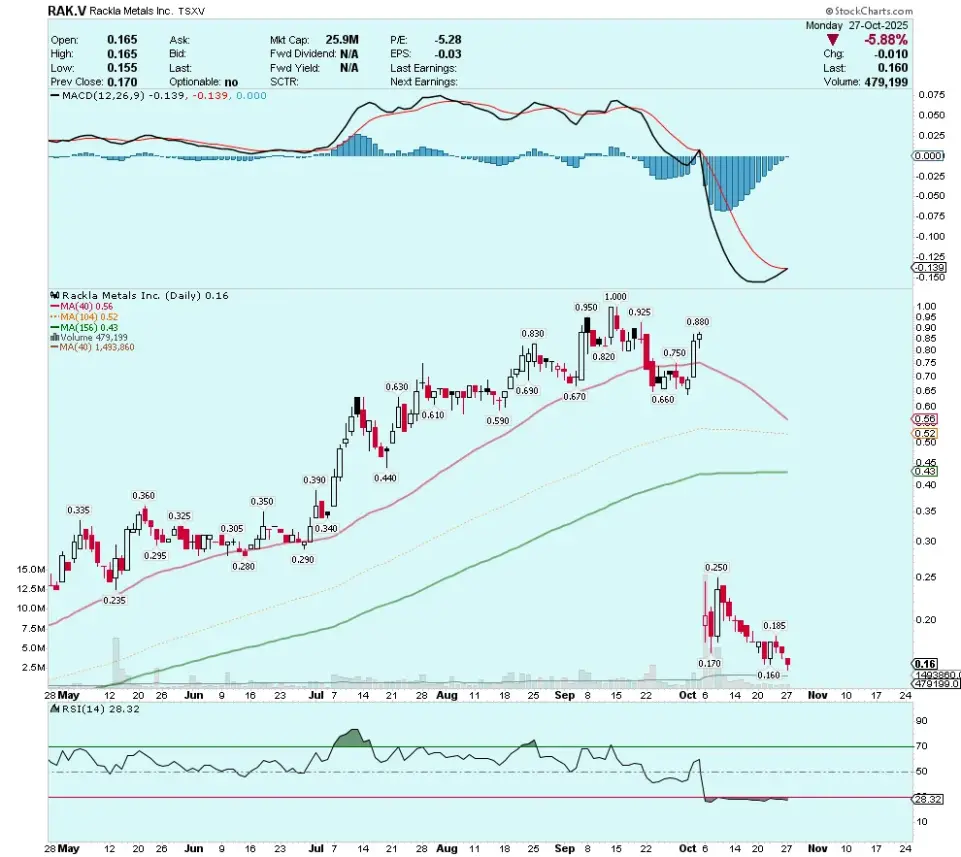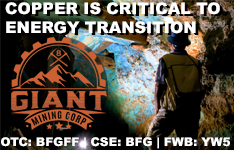Below is an interview by Robert Sinn of Goldfinger Capital with Bob Moriarty of 321Gold.
Goldfinger: I'm delighted to present another comprehensive conversation with the creator of 321Gold, Bob Moriarty. In this edition, we explore the current sentiment in precious metals markets and examine why the traditional year-end tax-driven selling in junior mining companies will have a different character this year compared to past seasons.
Let's talk about precious metals, Bob. Since our previous conversation, both gold and silver have reached new peaks, hitting even greater heights. Silver nearly touched $55 per ounce before forming what looks like a double top in mid-October, then retreating roughly 15%. It's now stabilizing around $40. Gold sits at approximately $4,100. How do you interpret this recent pullback?

Bob Moriarty: We need to consider two elements here. As you know, I approach markets from a contrarian perspective. Gold advanced for nine consecutive weeks. The statistical probability of such a streak is approximately one in 512 — it's two raised to the eighth power. Such an occurrence happens roughly once per decade, and potentially signals trouble ahead. Personally, I find $4,400 gold to be almost absurdly high. My assessment is that holders of American government debt are recognizing the diminishing future value of their bonds. I believe we're witnessing a migration from the U.S. treasury market into precious metals. If this transition continues, gold prices could theoretically reach extraordinary levels. Figures like $10,000, $20,000, and even $50,000 become mathematically possible.
Such scenarios would actually be financially devastating for the broader economy. So $4,400 gold actually makes me nervous. However, Clive from clivemaund.com, I, and several other analysts accurately predicted this correction, pinpointing almost the exact day. I don't view this pullback as particularly severe, and it hasn't been so far. Nevertheless, I'd prefer to see a correction lasting one or two months, which I anticipate will happen. Ultimately, I believe precious metals prices now reflect bond market dynamics more than traditional metals market factors.
Goldfinger: You mentioned "several other analysts," and I was among them. I should offer a minor correction regarding your 512-to-1 odds of gold rising nine straight weeks. It's not exactly a 50/50 proposition each week — historically, gold tends to rise more often than fall, so the probability is closer to 60/40 in favor of increases. This would put the odds more in the 400-to-1 range, roughly speaking.
Bob Moriarty: The distinction between 400-to-1 and 500-to-1 is essentially meaningless in this context.
Goldfinger: I simply wanted to add that slight clarification. Regarding market sentiment indicators like the DSI, what's your assessment? My view is that we haven't witnessed a major market top.
Bob Moriarty: Absolutely not a major top. The Daily Sentiment Index — I wrote a brief article about this on Monday, perhaps 100-200 words total. I identified the peak almost precisely, with the DSI reaching 89. For historical comparison, on April 25, 2011, silver's DSI hit 97. Going back to January 21, 1980, silver's DSI registered 95. We haven't yet seen the ultimate peak in either precious metal. However, a reading of 89 certainly suggests a normal corrective phase was due.
Goldfinger: Completely agree.
I anticipate continued volatility over the coming weeks as gold and silver establish a consolidation pattern. It's premature to call a definitive bottom in this correction phase, but that wasn't a major market peak. There's a strong likelihood we'll see fresh highs exceeding $4,400 for gold within several months, and silver should eventually return to the mid-to-upper $50 range.
The Russia-U.S. sanctions situation represents another theatrical performance unfolding recently. Initially, Trump declared Putin a close ally and extended an Alaska invitation. Clearly, Putin wasn't receptive during those Alaskan discussions.
The meeting concluded abruptly without even the scheduled dinner, and he departed immediately. Since then, relations appear to have steadily deteriorated over recent months.
Now, in this second Trump administration, we're seeing sanctions imposed on Rosneft and other Russian petroleum companies, essentially attempting to pressure China and India into boycotting Russian oil. What's your perspective? Personally, I think halting Russian oil flows will prove extremely difficult because significant financial incentives exist.
Bob Moriarty: Naturally. However, that's not the most concerning aspect. Are you familiar with the recent terrorist incident targeting a refinery in Hungary?
Goldfinger: There have been numerous attacks on energy infrastructure throughout Europe, Russia, and Ukraine. It's essentially become a strategic campaign targeting energy assets.
Bob Moriarty: True, but my specific point concerns attacks on Russian-affiliated facilities in both Romania and Hungary — both NATO member states. Theoretically, they could invoke Article 5 collective defense provisions. These strikes almost certainly originated from Ukraine. What's alarming is how this conflict continuously escalates. I find this deeply troubling and concerning.
Goldfinger: Definitely, the situation is worsening. Russian forces are launching intercontinental ballistic missiles at Ukrainian energy infrastructure alongside cruise missiles, while Ukraine responds with swarms of drones destroying critical components of Russian power systems. Fuel prices within Russia are climbing because refineries are being disabled. The situation has become quite grave.
Bob Moriarty: The same applies to Hungary, Romania, and certainly Ukraine. Many people across these regions — including Ukraine, Russia, Hungary, Slovakia, and Romania — face potential freezing conditions this winter. I genuinely wish this conflict would end. I certainly don't view Trump as a rational mediator in this situation, though I'm confident Putin communicated his position clearly. We should remember that Putin explicitly outlined his requirements to NATO back on December 21, 2021, but those demands were completely disregarded. European leadership seems almost determined to perpetuate this conflict. I consider that approach utterly foolish.
Goldfinger: Let's explore this more thoroughly. Trump possesses extraordinary self-confidence — something he's demonstrated throughout his life. Evidently, his mother repeatedly assured him he was exceptional, brilliant, and destined for greatness. Later, when entering business with substantial financial backing from his father, he received similar messages about becoming a remarkable billionaire and extraordinary success. He internalized these affirmations completely and genuinely believes himself to be uniquely capable of resolving any situation, even when lacking a fundamental understanding of complex conflicts.
His primary motivation seems to be stopping active hostilities, receiving a Nobel Peace Prize, and orchestrating a grandiose celebration of his supposed impossible achievement. That's his singular focus. However, the reality is that Ukraine-Russia differences have become fundamentally irreconcilable. Complete resolution requires leadership changes in both nations, not just one.
That's the only viable pathway forward. Clearly, both populations are exhausted by this conflict. It's obviously damaging both countries and their citizens. Russia faces serious demographic challenges — its population has been declining for two decades, and it's lost hundreds of thousands of young men in Ukraine over the past three and a half years. Their demographic crisis exceeds anything confronting the United States. Perhaps European leaders recognize Russia cannot ultimately prevail in this conflict.
Bob Moriarty: Ukraine's demographic situation is actually worse. They started with 57 million people and have dropped to approximately 20 million currently, including about 1.7 million dead or deserted.
Goldfinger: Yes, because massive numbers of people abandoned the country.
Bob Moriarty: Certainly they did. But their exodus created enormous burdens for Poland, Romania, Germany, France, and Europe collectively. This represents the most senseless conflict in modern history, and I've personally participated in a particularly pointless war myself. There was absolutely no justification for this conflict. Discussing Ukrainian NATO membership was profoundly misguided.
Goldfinger: Indeed, the historical roots run deep, and the situation is highly complex. Simply put, Russia has always viewed Ukraine as essentially a dependent state under its influence, similar perhaps to how America might regard Canada or Mexico, or Britain views certain territories. That's accurate. When Putin perceived that the new Ukrainian leadership wasn't respecting this relationship, he took drastic measures.
It's unfortunate, and I sincerely hope this struggle concludes. However, I'm not particularly optimistic at this point. I previously thought Trump might achieve some unexpected breakthrough. Currently, Ukraine faces serious challenges, and Russia confronts equally significant problems. The overall situation remains deeply troubling.
Bob Moriarty: I completely agree. This conflict should never have erupted, and many crucial factors are routinely overlooked. Both the original Minsk agreement and Minsk II explicitly provided for self-determination rights for breakaway regions, under frameworks established by Germany, France, and Britain. These regions voted overwhelmingly — twice — against remaining under Ukrainian governance.
Regarding your earlier point about Ukraine, Russia has historically utilized Ukraine as a strategic buffer zone. The word "Ukraine" literally translates as "borderlands," serving traditionally as protection against European invasions. Napoleon entered Ukraine with 500,000 troops and departed with merely 30,000. Similarly, Hitler, who despite certain tactical competence, fundamentally misunderstood Russia's vast geographical expanse and national determination.
Russia perceives this conflict in existential terms. For the United States and NATO, it lacks that existential quality, and they had no necessity to interfere in Ukraine, yet they did. The 2014 coup effectively constituted an intervention, and we're only now discovering that Victoria Nuland's previously cited figure of $5 billion spent overthrowing Ukraine's democratically elected government apparently understates the reality — it's closer to $10 billion. That represents an enormous expenditure from my perspective. We entangled ourselves in a situation offering no strategic benefit, creating widespread suffering, and the failure to negotiate a resolution remains incomprehensible to me.
Rackla Metals
Goldfinger: Shifting topics to junior mining, Bob, when we last spoke, we discussed Rackla Metals Inc. (RAK:TSX.V).
You've maintained a positive outlook on this company throughout the summer.
I believe the stock moved from mid-20 cents to a full dollar, then released initial results and subsequently plummeted.
What's your current assessment?

Bob Moriarty: I acquired shares back in January at eight-and-a-half cents. The stock appreciated from that level to a full dollar, and at that price point, it had clearly become overvalued. I've never encountered any mining venture that produced a major discovery in its initial three drill holes.
I believe the market reaction was excessive, and I actually accumulated substantial additional shares when it fell below twenty cents. I maintain significant faith in Simon Ridgeway and his team, and they've gathered valuable data. We've confirmed gold presence and understand the geological system. Seven additional holes remain pending, and I anticipate that holes numbered four through ten could potentially include a significant discovery. The company maintains $10 million in its treasury against just a $28 million market capitalization, so Rackla still represents a reasonable investment opportunity.
However, those of us (myself included) who expected immediate success in the first three holes were mistaken, and that miscalculation proved costly. Nevertheless, the company operates under one of the mining sector's most capable leaders. Their property sits within the Tombstone Belt. All the regional players — you've mentioned Banyan Gold Corp. (BYN:TSX.V; BYAGF:OTCQB;) countless times, plus Sitka Gold Corp. (SIG:TSXV; SITKF:OTCQB; 1RF:FSE), Trifecta Gold Ltd. (TG:TSX.V:TRRFF:OTCQB), and certainly Snowline Gold Corp. (SGD:TSX.V; SNWGF:OTCQB) — possess compelling narratives. I firmly believe the Tombstone Belt will emerge as the leader in the coming phase of the bull market, which should resume after this correction concludes. I maintain strong confidence in Rackla — while unjustified at one dollar, at $0.17 per share, it represents an attractive opportunity.
Goldfinger: Excellent points. Regarding your observations on the Tombstone gold district spanning Yukon Territory into Alaska and partially into the Northwest Territories — it's truly remarkable. I consider it among the world's most promising emerging gold regions, comparable with Finnish discoveries, the Chibougamau area, and certain West African zones like Côte d'Ivoire. Among the handful of emerging gold districts in the mid-2020s, Tombstone certainly ranks at or near the top. That's definitely favorable for Rackla, but this situation also provides an important lesson in risk management for junior mining investments.
With hindsight, we can acknowledge that one dollar was excessive for Rackla shares, though it wasn't immediately obvious at that moment. The stock demonstrated strong upward momentum. Many investors expressed optimism regarding potential assay results, and certainly, additional results remain pending.
We've only received the first group of holes. They might still report exceptional results from the six or seven remaining holes awaiting assay, but this underscores the importance of risk management, particularly with early-stage exploration companies where assay announcements dramatically impact market valuations. The higher a stock climbs, the greater market expectations become, increasing downside vulnerability.
Bob Moriarty: Very true, but examining the technical information available for this deposit, they identified a 550-meter zone averaging 1.06 grams per tonne from a 94-gram sample. Gold presence is confirmed, and based on my interpretation of the drilling pattern, the weakest holes came first, while the most promising ones appear to be in the upcoming batch. I remain reasonably optimistic about the company's prospects. There could be a turnaround — though somewhat humorous — they'll probably receive their assay results sometime next spring (sarcastically).
The Tombstone district has experienced such extensive drilling activity that laboratory backlogs are substantial. Labs are essentially telling companies, "We'll deliver your results eventually." If their upcoming assays reveal something like a 200-meter section averaging two grams of gold, the stock would immediately return to the one-dollar level.
Goldfinger: Absolutely. A 200-meter intercept at 2 grams per tonne would represent a Snowline-caliber discovery and restore the dollar share price. So you're accumulating Rackla at the current $0.17 level, Bob?
Bob Moriarty: Correct. Not precisely at $0.17, but I've placed low-priced limit orders. I genuinely appreciate market corrections as they create wonderful opportunities. My approach involves placing seemingly unreasonable bids on quality companies at apparently absurd prices, and you'd be amazed at how frequently those orders get filled.
Market sentiment became overly enthusiastic. We've witnessed significant retracement across the entire gold sector, creating an exceptional buying opportunity. The ultimate peak in precious metals prices remains ahead of us.
Tax Loss Selling
Goldfinger: This brings us to our final discussion topic: tax-loss selling season. The year 2025 presents a somewhat different scenario, Bob, since we've experienced substantial gains across precious metals and mining sectors. Most investors currently hold profitable portfolios for 2025. However, not every stock has appreciated.
Rackla represents one example; another company I follow closely, Ramp Metals Inc. (RAMP:TSXV), suffered a major decline following disappointing assay results.
So examples of underperforming stocks exist in 2025, and now we're approaching late October. How do you anticipate this year's tax-driven selling will unfold in the junior mining space?
Bob Moriarty: I expect it won't offer the same exceptional opportunities as previous seasons, when fundamentally sound companies with adequate financing, capable management, and promising projects faced indiscriminate selling pressure. Certain situations, like Ramp's, demonstrate this phenomenon. They reported an extraordinary initial drill result. I can't recall the exact figures.
Goldfinger: They intersected 7.5 meters grading 73 grams per tonne gold.
Bob Moriarty: I actually contacted them directly and warned, "You've created a challenging situation for yourselves." When they asked for clarification, I explained they'd established such elevated expectations that matching this performance would prove extremely difficult. The mystery remains how they encountered such remarkable mineralization initially, but subsequently reported disappointing results. Their share price suffered accordingly. I'm uncertain what valuation would represent an appropriate value for their shares.
Regarding Rackla, they maintain CA$10 million cash reserves and face no immediate financing requirements. Their next year's exploration program is already fully funded. We anticipate receiving seven additional drill results from this year's program (which might arrive in several years, humorously speaking), plus whatever next year's program eventually reveals.
Numerous junior companies have completed substantive drill campaigns. However, with gold trading around $4,200 an ounce, we're not discussing inexpensive metal prices. At such levels, even backyard prospecting becomes potentially viable. Consequently, many compelling investment narratives will emerge. I don't anticipate tax-loss selling will be particularly severe this year. What will drive prices lower is the broader market correction, which I welcome enthusiastically.
Goldfinger: Interesting that you referenced Ramp Metals. They currently carry a CA$12 million market capitalization with approximately CA$4.8 million in treasury, while you mentioned Rackla holds CA$10 million cash with a CA$28 million market cap. The comparison proves instructive. Ramp represents less than half of Rackla's market value but possesses roughly half the treasury assets.
One potential advantage for Rackla involves their pending assay results from summer drilling, which maintains some investor optimism. However, obviously, if those remaining ten holes deliver poor results, Bob, the situation could deteriorate dramatically.
Bob Moriarty: The shares would likely retreat to around $0.085 each.
Goldfinger: Right, approximately eight cents.
Bob Moriarty: Though I believe Ramp still awaits additional drill results.
Goldfinger: No, those were released last week. They announced them last week.
Bob Moriarty: So they proved disappointing.
Goldfinger: Correct, they were underwhelming. They currently maintain a CA$12 million market capitalization with roughly CA$5 million available. They're planning phase three drilling at Rottenstone SW in early 2026, around the January-February timeframe. They possess sufficient capital for another exploration program without requiring additional financing.
That represents a positive factor. Similar advantages apply to Rackla, which maintains substantial treasury reserves, allowing it operational flexibility without mandatory financing unless it choosees that option.
Bob Moriarty: Exactly. Having experienced the markets through the 1970s and 1980s, I can confidently predict that dozens of junior companies will appreciate from pennies to dollars per share. This represents a genuinely unique investment opportunity.
Goldfinger: You're describing a once-in-a-lifetime chance to invest in junior mining stocks?
Bob Moriarty: Precisely.
Goldfinger: What timespan do you envision for this investment window in junior mining companies?
Bob Moriarty: Multiple years. A fascinating perspective comes from French academic Emmanuel Todd, who authored The Defeat of the West. He describes the collapse of Western debt-based economic systems and an ongoing power transition from Western nations toward Eastern regions.
This shift began in 1492 when Columbus reached the Bahamas. Within several decades, Spain undertook extraordinary efforts to discover substantial gold and silver deposits across Bolivia, Peru, Mexico, and Colombia. Wealth flooded into Europe, transforming the continent from a relatively undeveloped region into a global leader. Today, we're witnessing the exact opposite phenomenon, power gravitating toward the Global South and Eastern nations.
I find it puzzling why any logical observer would believe America could successfully challenge China. They represent an enormously populous nation with remarkably industrious citizens. While I don't necessarily endorse all their policies or approaches, Western influence is undeniably declining. As this decline progresses, tangible assets, including precious metals and mining enterprises, will correspondingly increase in value.
Goldfinger: Those controlling the gold establish the rules. Thank you, Bob. I appreciate you sharing your insights.
Bob Moriarty: You're welcome. It's been a productive exchange.
You can read more from Robert Sinn here.
| Want to be the first to know about interesting Gold and Silver investment ideas? Sign up to receive the FREE Streetwise Reports' newsletter. | Subscribe |
Important Disclosures:
- As of the date of this article, officers, contractors, shareholders, and/or employees of Streetwise Reports LLC (including members of their household) own securities of Snowline Gold Corp.
- Robert Sinn: I, or members of my immediate household or family, own securities of: Ramp Metals. My company has a financial relationship with: None. My company has purchased stocks mentioned in this article for my management clients: None. I determined which companies would be included in this article based on my research and understanding of the sector.
- Bob Moriarty: I, or members of my immediate household or family, own securities of: Snowline Gold Corp. and Rackla Metals. My company has a financial relationship with: Rackla Metals. My company has purchased stocks mentioned in this article for my management clients: None. I determined which companies would be included in this article based on my research and understanding of the sector.
- Statements and opinions expressed are the opinions of the author and not of Streetwise Reports, Street Smart, or their officers. The author is wholly responsible for the accuracy of the statements. Streetwise Reports was not paid by the author to publish or syndicate this article. Streetwise Reports requires contributing authors to disclose any shareholdings in, or economic relationships with, companies that they write about. Any disclosures from the author can be found below. Streetwise Reports relies upon the authors to accurately provide this information and Streetwise Reports has no means of verifying its accuracy.
- This article does not constitute investment advice and is not a solicitation for any investment. Streetwise Reports does not render general or specific investment advice and the information on Streetwise Reports should not be considered a recommendation to buy or sell any security. Each reader is encouraged to consult with his or her personal financial adviser and perform their own comprehensive investment research. By opening this page, each reader accepts and agrees to Streetwise Reports' terms of use and full legal disclaimer. Streetwise Reports does not endorse or recommend the business, products, services or securities of any company.
For additional disclosures, please click here.
Robert Sinn Disclosures
The work included in this article is based on current events, technical charts, company news releases, corporate presentations and the author’s opinions. It may contain errors, and you shouldn’t make any investment decision based solely on what you read here. This publication contains forward-looking statements, including but not limited to comments regarding predictions and projections. Forward-looking statements address future events and conditions and therefore involve inherent risks and uncertainties. Actual results may differ materially from those currently anticipated in such statements. This article is provided for informational and entertainment purposes only and is not a recommendation to buy or sell any security. Always thoroughly do your own due diligence and talk to a licensed investment adviser prior to making any investment decisions. Junior resource companies can easily lose 100% of their value so read company profiles on www.SEDARplus.ca for important risk disclosures. It’s your money and your responsibility.













































